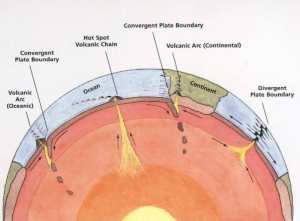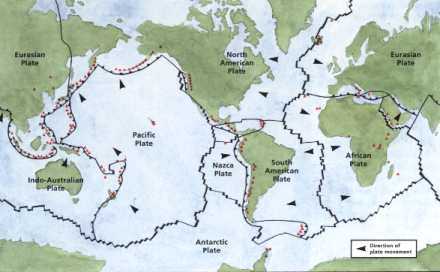
Geographical repartition of the fatalities caused by volcanic eruptions - From 1600 to 2000 about 300.000 people died by volcanic eruptions over the world
Location of volcanoes
Many volcanoes are located at the edges of lithospheric plates. Along the mid-ocean ridges (spreading zone), the plates are moving apart and new crust is being formed. Along subduction zones, plates collide and one plate is subducted beneath the other. lntraplate volcanoes are located in the interior of oceanic or continental plates.


Morphology, and product of volcanoes
Volcanoes range from small scoria cones to large stratovolcanoes and shield volcanoes. The morphology of a volcano depends on the eruption processes which are largely governed by the chemical composition and volatile content of a magma. For instance, the higher the percentage of silica (SiO2) in a magma, the higher its viscosity and the more explosive the eruptions. Highly liquid, basaltic lava builds shallow, broad shield volcanoes, whereas stratocones are formed by explo-sive and effusive activity of' more viscous magmas. Hazard assessment of volcanoes must consider the morphology and environment. The products of volcanic eruptions include lava, fragments (tephra), and intrusions. Tephra is classified according to the grain size of fragments into ash " 2 mm " , lapilli " 2-64 mm ", and bombs or blocks " > 64 mm ". Attempts have been made to classify the intensity of a volcanic eruption, i.e., its volume and explosive power. Recently, the Explosive Volcanic Index has been used. The index is calculated from the volume of erupted material and the height of the eruption plume. Additionally, qualitative descriptions of an eruption are used to determine the index.

Types of dangerous volcanic activity
The longer a volcano has been inactive, the greater, usually, the volume of the ejected masses and the more explosive the eruption. Long periods of dormancy between eruptions are characteristic for many volcanoes. The question of when to call a volcano extinct is not easy to answer some volcanoes become active again after thousands or hundreds of thousands of years High-risk volcanoes are volcanoes that ( I ) erupt one or more times during onc decade, (2) are poorly investigated or monitored, and (3) have dense populations inhabiting the area. Following the emptying of a large magma reservoir, the top volcanic structure collapses, and a caldera is formed. If magma encounters groundwater during its ascent toward the Earth's surface, an explosion-Iike vaporisation or the water occurs, (phreatic explosion when only wall rock is fragmented; phreato-magmatic when new magma is involved). Such eruptions are often acompanied by base surges, currents of immense destructive power which consist of gases, and fragmented rock flowing horizontally and radially away from the eruption center.